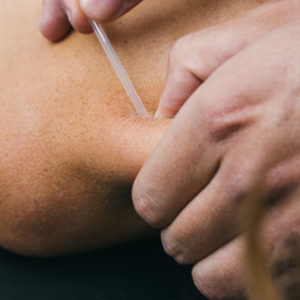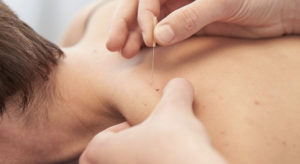CORE Physical Therapy In Omaha Explains… 6-11-21
By Dr.Mark Rathjen PT DPT CSCS
CORE Physical Therapy Co-owner
17660 Wright St. 9/10
Omaha NE
402-933-4027
Trigger point dry needling is a new form of modalities that trained physical therapists can utilize to better treat muscular pain. We specialize in athletic populations overall, and we can use this modality to get our athletes back to action 50% faster. Dry needling utilizes as small needle to insert into the muscle trigger point (painful knot) and we illicit a twitch response. That response regulated by the nervous system will contract the muscle at a high rate, and subsequently will reset the muscle back to a “resting” phase.
This allows the muscle to relax and get blood flow back to normal conditions.
CORE Physical Therapy and Sports Performance in Omaha can perform these modalities when need to the get a muscle back to baseline and allow a doctor of physical therapy to figure out the root cause of the issue is. Most of the time, a knotted muscle that is painful is a result in a Biomechanical overuse or compensation pattern issue somewhere else in the system.
At CORE Physical Therapy in Omaha, We specialize in the treatment of athletes. We have worked with athletes for a combined 30 years. CORE was established in 2015 by Dr. Mark and Dr. Claire Rathjen is family owned and operated.
We are proud to serve the greater Omaha metro area.
For More information, Please feel free to contact us http://coreomaha.com/contact/
Please feel free to follow us at https://www.facebook.com/COREomaha/
To get started http://coreomaha.com/getting-started/
For more Blog information http://coreomaha.com/blog/
Youtube Account linked below.
https://www.youtube.com/channel/UCVg8OSN5h-i1n_ykw1Gvahg?view_as=subscriber
Dry Needling for the Treatment of Tension-Type, Cervicogenic, or Migraine Headaches: A Systematic Review and Meta-Analysis
- PMID: 33609358
- DOI: 10.1093/ptj/pzab068
Abstract
Objective: Dry needling is a treatment technique used by clinicians to relieve symptoms in patients with tension-type headache (TTH), cervicogenic headache (CGH), or migraine. This systematic review’s main objective was to assess the effectiveness of dry needling on headache pain intensity and related disability in patients with TTH, CGH, or migraine.
Methods: Medline/PubMed, Scopus, Embase, PEDro, Web of Science, Ovid, Allied and Complementary Medicine Database/EBSCO, Cochrane Central Register of Controlled Clinical Trials, Google Scholar, and trial registries were searched until April 1, 2020, along with reference lists of eligible studies and related reviews. Randomized clinical trials or observational studies that compared the effectiveness of dry needling with any other interventions were eligible for inclusion. Three reviewers independently selected studies, extracted data, and assessed risk of bias. Random-effects meta-analyses were performed to produce pooled-effect estimates (Morris dppc2) and their respective CIs.
Results: Of 2715 identified studies, 11 randomized clinical trials were eligible for qualitative synthesis and 9 for meta-analysis. Only 4 trials were of high quality. Very low-quality evidence suggested that dry needling is not statistically better than other interventions for improving headache pain intensity in the short term in patients with TTH (SMD -1.27, 95% CI = -3.56 to 1.03, n = 230), CGH (SMD -0.41, 95% CI = -4.69 to 3.87, n = 104), or mixed headache (TTH and migraine; SMD 0.03; 95% CI = -0.42 to 0.48, n = 90). Dry needling provided significantly greater improvement in related disability in the short term in patients with TTH (SMD -2.28, 95% CI = -2.66 to -1.91, n = 160) and CGH (SMD -0.72, 95% CI = -1.09 to -0.34, n = 144). The synthesis of results showed that dry needling could significantly improve headache frequency, health-related quality of life, trigger point tenderness, and cervical range of motion in TTH and CGH.
Conclusions: Dry needling produces similar effects to other interventions for short-term headache pain relief, whereas dry needling seems to be better than other therapies for improvement in related disability in the short term.
Impact: Although further high-methodological quality studies are warranted to provide a more robust conclusion, our systematic review suggested that for every 1 or 2 patients with TTH treated by dry needling, 1 patient will likely show decreased headache intensity (number needed to treat [NNT] = 2; large effect) and improved related disability (NNT = 1; very large effect). In CGH, for every 3 or 4 patients treated by dry needling, 1 patient will likely exhibit decreased headache intensity (NNT = 4; small effect) and improved related disability (NNT = 3; medium effect).
Keywords: Cervicogenic Headache; Dry Needling; Meta-Analysis; Migraine; Systematic Review; Tension-Type Headache.
© The Author(s) 2021. Published by Oxford University Press on behalf of the American Physical Therapy Association. All rights reserved. For permissions, please email: journals.permissions@oup.com.
Similar articles
-
Chiropr Man Therap. 2019 Sep 26;27:43. doi: 10.1186/s12998-019-0266-7. eCollection 2019.PMID: 31572570 Free PMC article.
-
Cephalalgia. 2016 Apr;36(5):474-92. doi: 10.1177/0333102415597889. Epub 2015 Jul 30.PMID: 26229071 Review.
-
Disabil Rehabil. 2020 Sep 12:1-10. doi: 10.1080/09638288.2020.1813817. Online ahead of print.PMID: 32924640
-
BMC Musculoskelet Disord. 2021 Mar 3;22(1):243. doi: 10.1186/s12891-021-04105-y.PMID: 33657998 Free PMC article.
-
Aspirin for acute treatment of episodic tension-type headache in adults.
Cochrane Database Syst Rev. 2017 Jan 13;1(1):CD011888. doi: 10.1002/14651858.CD011888.pub2.PMID: 28084009 Free PMC article. Review.


